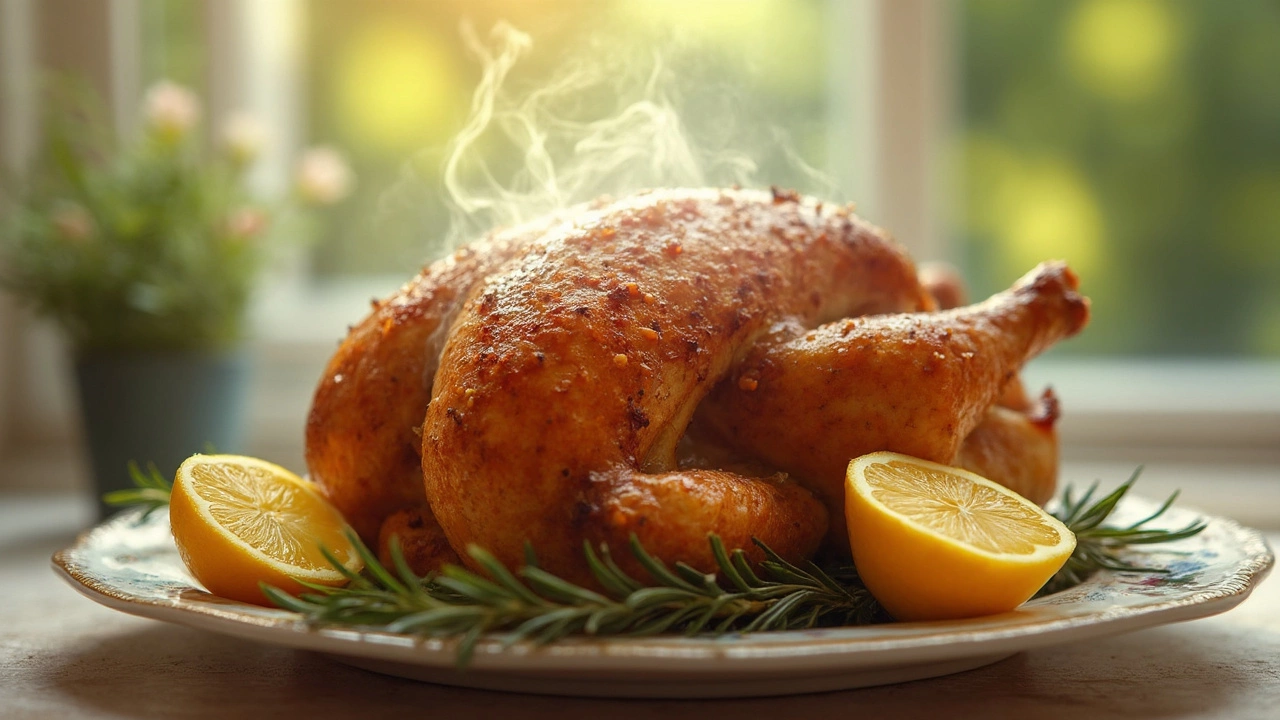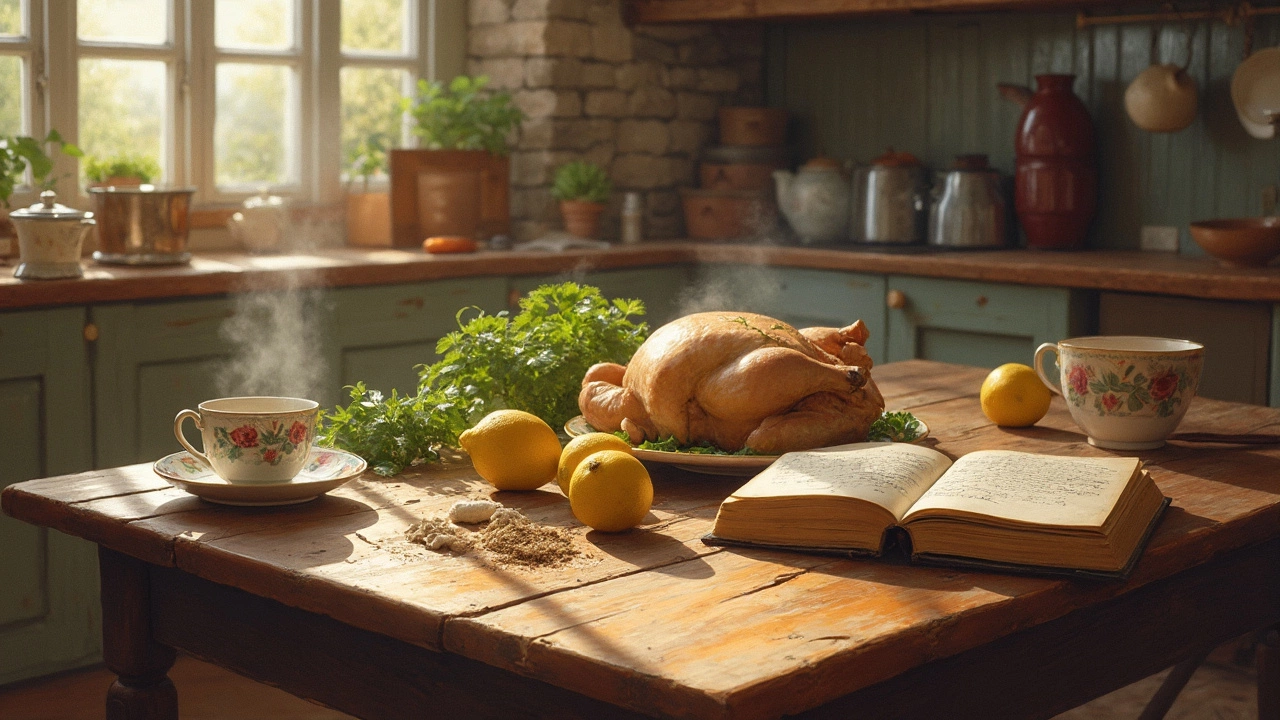Have you ever taken a bite of chicken only to find it dry and lacking flavor? You're not alone. Keeping chicken soft and juicy is a challenge many face, but it doesn't have to be that way. Let's break down the simple steps that lead to perfectly cooked chicken every time.
First up, understanding the meat itself. Chicken is leaner compared to red meats, which means it can dry out if overcooked. Choosing quality chicken is crucial. Fresh, not frozen, can often yield better results as freezing can alter the texture of the meat. But don't worry if you're using frozen—just make sure it's fully thawed for even cooking.
- Understanding Chicken Meat
- The Role of Marination
- Cooking Methods That Preserve Juiciness
- Temperature Control: The Key to Tenderness
- Resting Chicken After Cooking
Understanding Chicken Meat
When it comes to achieving tender, juicy chicken, knowledge is power. Let's start with the basics. Chicken is primarily composed of two types of muscle fibers: white and dark. The white meat, found in the breast, cooks faster and has less fat, which makes it prone to drying out. On the other hand, dark meat, such as thighs and drumsticks, contains more fat and connective tissue, making it naturally more flavorful and forgiving when cooked.
Quality matters, too. Picking the right chicken at the store sets the stage for maintaining that sought-after moisture. Look for meat that is pink with little to no scent. If possible, opt for organic or free-range chickens, as they tend to be juicier and more flavorful without the need for added hormones or antibiotics.
White vs. Dark Meat
Understanding the distinction between white and dark meat can aid in choosing the right cut for your dish. White meat is great for stir-fries or other quick-cooking methods, while dark meat shines in dishes that require longer cooking times, like stews or slow-cooked meals.
The anatomy also plays a role; chickens don't fly, so their breast muscles (white meat) are less exercised than their legs (dark meat), affecting the tenderness differently depending on the cooking method used.
Table on Meat Composition
| Type of Meat | Fat Content | Cooking Time |
|---|---|---|
| White Meat | Low | Short |
| Dark Meat | Higher | Longer |
So next time you're in the kitchen, think about the cooking methods that will complement each type of meat. The key is matching the cut with the recipe for the best chance at keeping your chicken deliciously moist.
The Role of Marination
Marination is a game-changer for getting that juicy chicken everyone loves. Think of it like giving your chicken a flavor bath. But what exactly does it do?
Marinades are typically made from a combination of acid, fat, and seasonings. The acid, often found in vinegar, lemon juice, or yogurt, breaks down the proteins in chicken, making it more tender and able to hold onto moisture. The fats, like olive oil or other oils, help distribute the flavors evenly, keeping the chicken moist during cooking.
How Long Should You Marinate?
Timing is also important. For chicken cuts like breasts or thighs, a few hours in the fridge is usually enough to soak in all those flavors. But if you're planning, leaving it overnight won't hurt either. Just remember, for smaller pieces or if you're using a particularly acidic marinade, you don't want to go too long, or the texture might get a bit mushy.
Marination Tips
- Use a sealable bag or airtight container to keep everything fresh and prevent leaks.
- Make sure the marinade covers the chicken completely for even soaking.
- Try adding herbs and spices like garlic, rosemary, or chili flakes for an extra punch.
- If you're short on time, try a dry rub instead of a wet marinade; it can be quicker to prepare and still packs a flavor punch.
People often overlook the importance of marination, but with these simple steps, you'll master the art of making soft chicken that's bursting with flavor.

Cooking Methods That Preserve Juiciness
When it comes to keeping your chicken juicy and soft, the cooking method matters more than you might think. Frying isn't the only way to retain those precious juices. Have you considered poaching or steaming?
Poaching: Gentle and Effective
Poaching is a gentle cooking method that's often overlooked. Simply simmer your chicken in a pot of water or broth until done. This method keeps the chicken moist because it's cooking in its own liquids. Plus, it adds extra flavor if you're using a tasty broth. As Julia Child once said in her famous cookbook,
"The way to a chicken's heart is through a gentle bath of flavor."
Steaming: Locks in Moisture
For those who prefer a more hands-off approach, steaming is perfect. It requires minimal effort and yields maximum juiciness. Place your chicken in a steamer basket over boiling water. The steam will cook the chicken gently, ensuring it remains tender.
Sous Vide: Precision Cooking
If you're a fan of gadgets, the sous vide method might be for you. This technique involves vacuum-sealing chicken in a bag and cooking it at a precise, low temperature in a water bath. While this requires some special equipment, it's almost foolproof for keeping chicken juicy. It's become a go-to for many chefs who crave consistency.
With all these methods, it's vital to keep an eye on cooking times and internal temperatures. Overcooking is a surefire way to end up with dry chicken. Armed with the right technique, you'll conquer any chicken recipe and impress dinner guests with how tender and flavorful your dish is.
Temperature Control: The Key to Tenderness
Temperature might just be your best friend when it comes to making sure your chicken stays soft and juicy. Cooking your chicken to the right temperature is crucial because it ensures the meat is cooked through without losing moisture. Let's break down how that works.
Keep an Eye on Numbers
Using a meat thermometer is the best way to get the job done right. Chicken is considered safe to eat at an internal temperature of 165°F (about 74°C). But here's a trick: to keep it juicy, remove the chicken from the heat a little before it hits that mark, around 160°F. It will continue to cook as it rests, reaching the safe temperature without going overboard.
The Danger of Overcooking
Overcooking is a common mistake and one of the main reasons for dry chicken. Going too far past the 165°F mark can make the meat tough and flavorless. So, aim to cook your chicken just right and resist the urge to leave it on the heat too long.
Resting Makes Perfect
Once you hit that magic number, it’s time to let your chicken rest. Resting allows the juices to redistribute throughout the meat instead of running out when you cut it. Cover the chicken with foil and give it 5-10 minutes. You'll notice a difference this small step will make in keeping your chicken tender.
Quick Cooking vs. Slow Cooking
- Grilling or Pan-Frying: High heat cooking methods take less time, but require close attention to temperature to prevent overcooking.
- Baking: Cooking at a moderate temperature allows the chicken to cook evenly and retain moisture.
- Slow Cooking: This method keeps everything moist with low, steady heat, but monitoring internal temperature is still essential.
Remember, keeping track of temperature isn't just a technicality. It's the secret to juicy chicken, every time you cook. So, the next time you're whipping up a chicken dish, grab that thermometer and take control of your cooking. You'll not only impress your guests but also make your meal truly enjoyable.

Resting Chicken After Cooking
It might surprise you, but one of the key steps to keeping that chicken juicy and soft happens after you've turned off the heat. Resting your chicken is just as important as the actual cooking itself. This little pause allows all those delicious juices to redistribute throughout the meat.
When chicken is fresh out of the oven or pan, the juices are often driven away from the center due to the heat. If you cut into it right away, all that flavorful moisture can end up on your cutting board instead of in your dish. Giving your chicken a break lets those juices calm down and soak back into the meat, making each bite more juicy.
How Long Should Chicken Rest?
Here's a simple rule of thumb: let your chicken rest for about 5 to 10 minutes before slicing or serving. For smaller cuts like breasts, closer to 5 minutes is enough. But if you've just roasted a whole chicken, aim for the upper range.
Better A Resting Place
Place the cooked chicken on a plate or cutting board, and don't cover it too tightly if you're using foil—just lightly is enough to maintain a bit of warmth without trapping too much steam, which could make the skin (if it's present) less appealingly crispy.
Think about resting chicken like finishing a good workout—it's your chicken's downtime to chill and regroup before the main event: making your meal absolutely delicious.
So next time you're cooking up some chicken recipes, remember this step, and you'll soon start to notice the difference it makes. A few extra minutes is a small investment for an exquisite payoff in flavor and texture.

